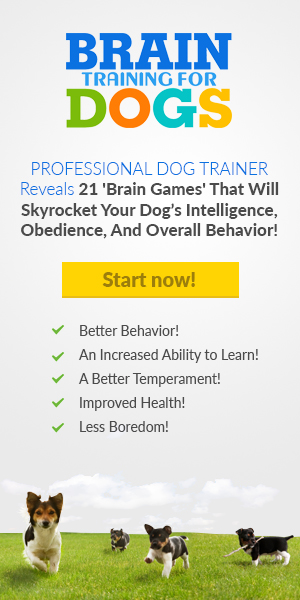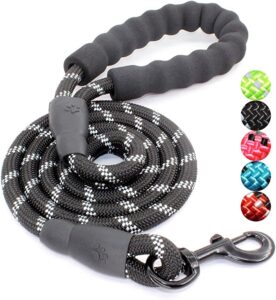On this page:
Resources:
How to stop your dog jumping up at guests is an important topic as probably most dog owners and dog lovers have had the experience of their pet embarrassing them or disappointing them at times, by jumping up on guests. Of course, we continue to love them nonetheless.

However, jumping up can lead to dangerous consequences for the elderly or young children. By implementing a few simple techniques, it is possible to teach your dog not to jump up. Let’s look at four such techniques:
Stay Calm
Dogs often jump up when they are excited to see us and use jumping as a way to get closer to us. Your dog often picks up on your aura. So, greet your pet calmly and with confidence, and then he/she will be more inclined to mirror your calm demeanor. Additionally, you may find it useful to ask your friends to be calm when greeting your dog too, because excitement can overstimulate your dog. As the owner you need to keep calm and be careful not to reward your dog’s attention seeking behavior.
You can turn away from your dog and ignore them for a minute. When we say “ignore your dog” this means totally ignore, that is, no eye contact and not speaking at all to him or her. Then, turn back and in a calm voice talk to him/her.
It is important that when your dog is calming down that he/she puts all four paws on the ground. Giving them attention straight way or being irritated rewards their behavior, as this tells them that it is okay to jump up, just the opposite of what you want them to do. By staying calm your dog will learn how to act in these situations by not being overstimulated.
See this technique demonstrated here:
This video is part of the Brain Training for Dogs program which will help you eliminate all kinds of behaviour problems and even allow your dog’s inner hidden intelligence to emerge.
Use Your Voice with Specific Commands
Teach your dog to recognize simple words such as “No”, “Off”, or “Down!” Using a word or command will create an association with the required behavior. Note however, you must be consistent and use these cue words often so that your dog can make the connection and respond immediately when given the command or when he/she hears the cue word.
Teaching your dog to sit is another technique you can use. As soon as your dog tries to jump up, tell them to “Sit” and then reward them with a treat on praise. In any case, avoid punishing your dog, as it does not fully understand punishment, and it may lead to your dog engaging in the undesirable behavior.
Alternative Physical Techniques
Sometimes, despite verbal commands, your dog might need more assistance to not jump up. There are various physical techniques that can help. Using a lead to teach your dog to stay at your heal can give you more control, so that your dog doesn’t have a lot of room for jumping up. Besides, you can also step on the lead so that he/she is not able to spring up. You can ask a friend to help you to complete a practice of greeting people, as this will give you and your dog more confidence.

Over 57,000 5-star reviews!
Praise and Reward
Reward based training is an effective technique. Find out what your dog likes as a reward and use this when he/she performs the correct behavior. Dogs also respond well to verbal praise. For example, saying “Good boy/girl” or using your dog’s name can encourage your dog to show you the good things he/she has learnt. Then again, you can create a game to teach your dog new behaviors and hold their interest. As with humans, dogs also enjoy physical touch such as petting as a display of affection.
Show your dog love and attention at other times, away from only jumping behavior. Allow your dog to feel that you enjoy their presence and that they don’t have to jump up. Definitely, in this way your dog can learn more appropriate ways of showing affection and excitement.
Patience & Repetition
When training your dog remember to be patient and repeat the techniques as often as needed. Moreover, some dogs are more enthusiastic and learn faster than others. In addition, some dog breeds are more excitable than others, so you may want to do some research on the breed. As long as you remain consistent and continue to follow through on your dog’s training you can expect him/her to make progress.
See some of these methods practically demonstrated by Steve Walsh of McCann Dogs with his Golden Retriever Emmett:
Stop Jumping Up in 4 Simple Steps
Summary of Video Transcript
I can show you how I got to the next level using a few simple tools, good timing and a little consistency. Now Emmett here struggles with jumping up. He’s like most dogs.
He loves people, so we’re going to work through how to teach him not to jump on me. We’re simply just using this line and some good timing. Now, oftentimes things happen with our dogs and we will react to them.
Let’s say our guests come over and the dog runs and jumps on them or we’re getting food out or we’re getting something and the dog gets really excited and they come and jump on us instead of waiting until those things happen.
Be Proactive
I want to teach you to be a little bit more proactive about installing the behaviors before they’re an issue and I’m going to give you some tools right now to do just that. Let’s give this a try. He’s going to jump a little bit. All I’m going to do with the benefit of my line is simply stand on it.
Notice, he jumped up a couple of times and realized that it wouldn’t get him anywhere. Therefore, this gives me the ability to prevent him from jumping without putting my hands on him at all and maybe confusing this situation with a little bit of an inadvertent reward.
Use Socks!
Not only does Emmett like to jump up, but Emmett also really, likes socks. So instead of waiting until he jumps up on the guest or somebody else, or instead of him running away and taking the socks for a little run, I’m actually going to use them to create a situation and kind of encourage him to jump, but not so that he jumps all the time. He gets rewarded for it, but he also learns not to jump and that’s where good timing is going to come in.
So, I’m going to use these socks to get him a little bit more excited so that he wants to jump. I’m going to use a tether leash on him to keep him from running around. Then, when he realizes he can’t jump, go up to him and if he doesn’t jump, good things happen. I want to make sure he understands not jumping.
The Result
He realizes he can’t jump. Nevertheless, I’m not pushing or wrestling or getting unintended rewards in that way. Nice boy What a great job. He really was okay. “Wait a minute. Um, but I think something good will happen if I lie down. okay And you can try again.” I will move again. Now he’s a bit flummoxed again so I’ll just stand my ground.
Rewards
He jumped up a few times, hit the end of his leash and sat down and I said yes to let him know he did a good job but he didn’t really. Reward him. OK I took a few steps to encourage him to move again and then gave him another option, at which point he decided to sit on his own rather than run. “If I put my feet on the ground, very, very good things will happen.” Again, I don’t care if he squats or lowers himself, but you can see how he jumped back the first time.
Yes, if he calms down, this time there is no reward. Good boy. A calm demeanor is good. All four feet on the ground until he decides to lie down again. I’ve been working on jumps and rewards and when he puts four feet on the ground and sees it is the best option he’s starts making great choices.
The Right Choices
If he makes the right choice, I will say “yes” and reward him for this excellent choice. I want to start with small, small steps so he can be successful every time. So, this time I’m going to see if I can excite him a little bit. OK good job. I want him to keep his feet on the ground. Good boy, good job.
Now when he gets all four feet on the ground my reward is a little extra bonus thrown in at the end. Now it’s time for you to jump a bit more excitedly. See how he quickly corrected himself.
Two Socks
He quickly put his feet on the ground and sat down carefully. I’m going to give him a quick little jackpot for this. So I will to try one more time. I’m going to really try and push my luck here and see what he can do. I’m going to make two socks. Yes, Good boy. So really clear choices from him and great timing from me to really let him know that this is the behavior that I like.
Here is additional expert advice from the
American Kennel Club
You will find this article helpful also:
How to Get Your Puppy to Stop Biting Hands
Podcast: Play in new window | Download
